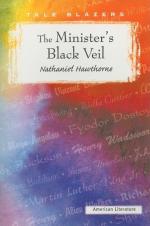|
This section contains 4,523 words (approx. 16 pages at 300 words per page) |

|
SOURCE: “The Artist's Symbol and Hawthorne's Veil: ‘The Minister's Black Veil’ Resartus,” in Studies in Short Fiction, Vol. 29, No. 3, Summer, 1992, pp. 353-62.
In the following essay, Freedman follows the lead of Carnochan's 1969 article and identifies the most important aspect of “The Minister's Black Veil” as Hawthorne's concern with the power of literary symbolism.
Decades of discussion of Hawthorne's “The Minister's Black Veil” have inevitably brought the question of the author's attitude toward the minister—whether he is a heroic martyr, a virulent anti-Christ, or some hybrid form between—to a point of diminishing critical returns. The tale was happily revitalized, its interpretive possibilities expanded, by W. B. Carnochan in 1969. In his essay, which offers a reading of the veil as a symbol of symbols, a paradoxical emblem of both revelation and concealment inherently resistant to fixed meanings, Carnochan opened a wide door into this parable and into Hawthorne's...
|
This section contains 4,523 words (approx. 16 pages at 300 words per page) |

|


